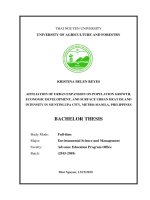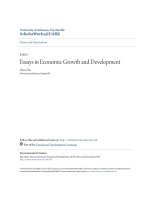Economic growth and economic development 642
Bạn đang xem bản rút gọn của tài liệu. Xem và tải ngay bản đầy đủ của tài liệu tại đây (95.61 KB, 1 trang )
Introduction to Modern Economic Growth
each of them to innovate. Each firm ignores its effect on the aggregate rate of innovation, thus takes η (LR ) as given (this assumption is not important as shown by
Exercise 14.20). Consequently, when the current machine quality is q, the free entry
condition takes the form
η (LR (q)) V (λq) = w (q) ,
where LR (q) is the number of workers employed in research when the current machine quality is q.
Let us now look for an equilibrium with the following cyclical property: the rate
of innovation differs when the innovation in question is an odd-numbered innovation
versus an even-numbered innovation (say with the number of innovations counted
starting from some arbitrary date t = 0). This type of equilibrium is possible
when all agents in the economy expect there to be such an equilibrium (i.e., it
is a “self-fulfilling” equilibrium). Denote the number of workers in R&D for odd
and even-numbered innovations by L1R and L2R . Then, following the analysis in the
previous subsection, in any equilibrium with a cyclical pattern the values of odd
and even-numbered innovations (with a machine of quality q) can be written as (see
Exercise 14.18):
V 2 (λq) =
(14.28)
βq (L − L2R )
βq (L − L1R )
1
and
V
(λq)
=
,
ρ + η (L2R ) L2R
ρ + η (L1R ) L1R
and the free entry conditions take the form
¡ ¢
¡ ¢
η L1R V 2 (λq) = w (q) and η L2R V 1 (λq) = w (q) ,
(14.29)
where w (q) is the equilibrium wage with technology of quality q. The reason
why η (L1R ) multiplies the value for an even-numbered innovation is because L1R
researchers are employed for innovation today, when the current technology is oddnumbered, but the innovation that this research will produce will be even-numbered
and thus will have value V 2 (λq). Therefore, we have the following two equilibrium
conditions:
(14.30)
¡ 2 ¢ λ (1 − β) q (L − L1R )
¡ 1 ¢ λ (1 − β) q (L − L2R )
= 1 and η LR
= 1.
η LR
ρ + η (L2R ) L2R
ρ + η (L1R ) L1R
628









